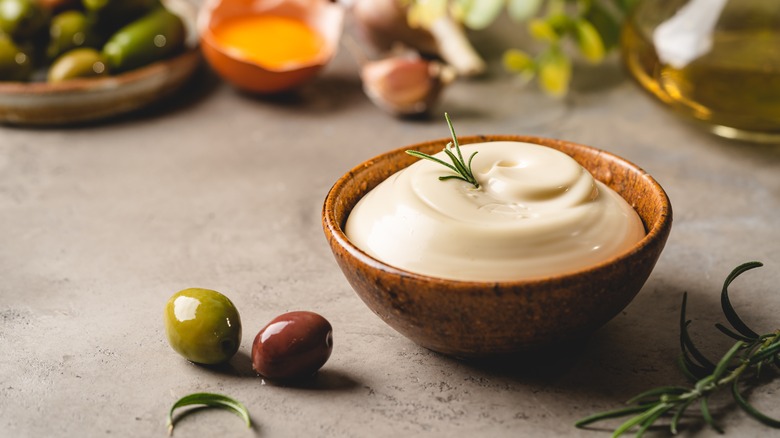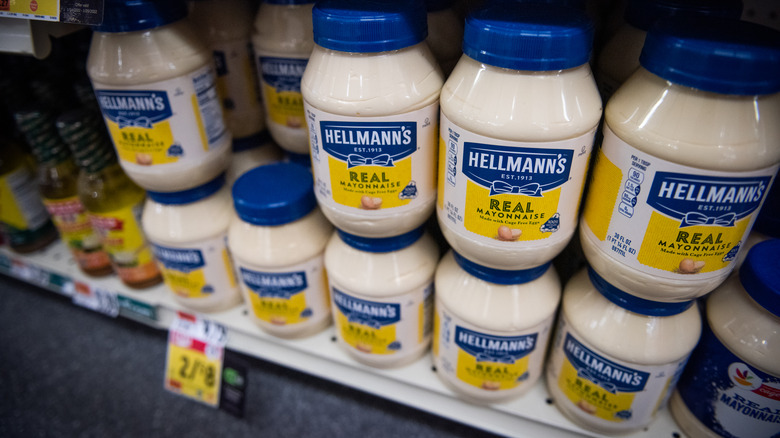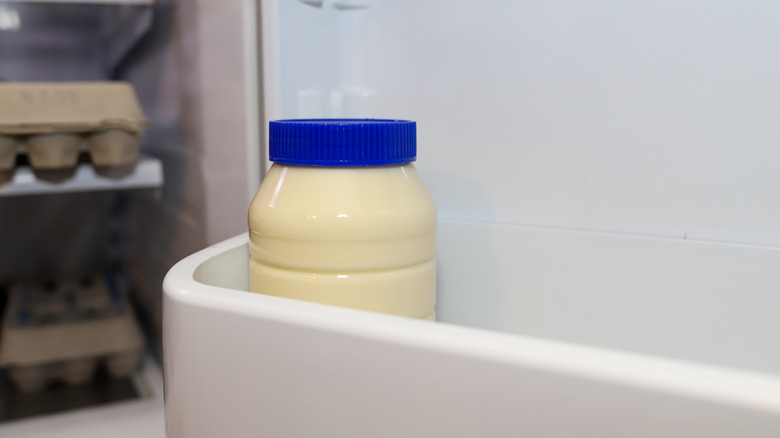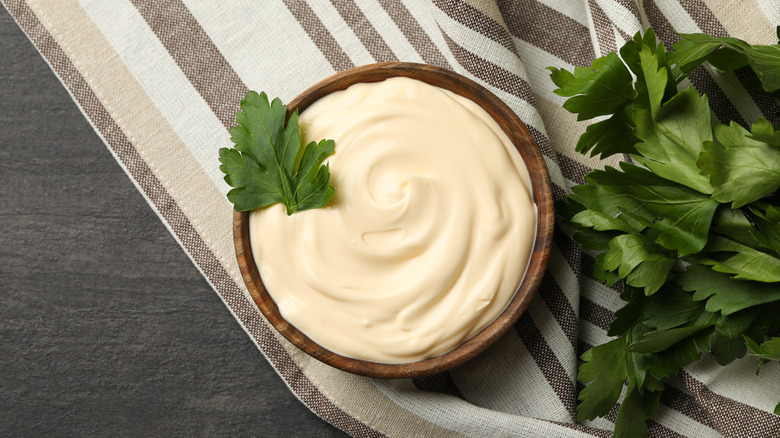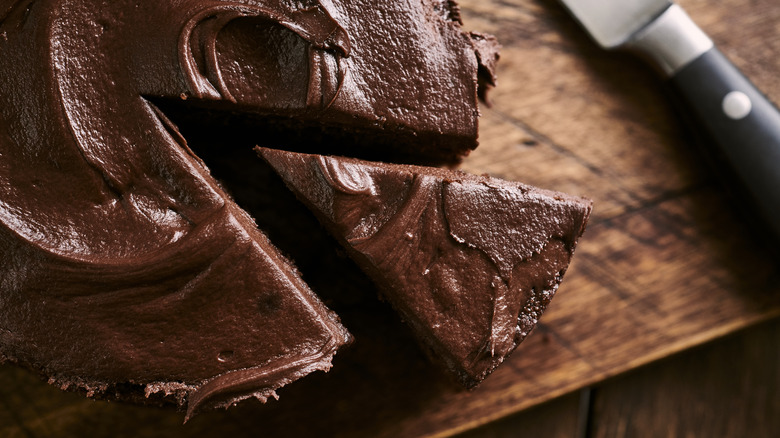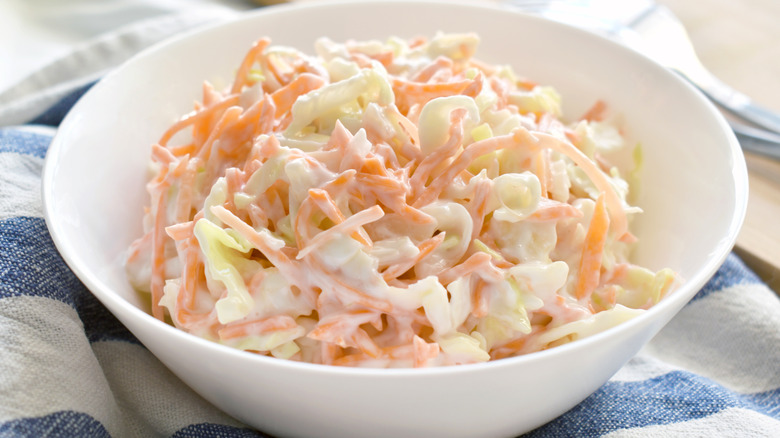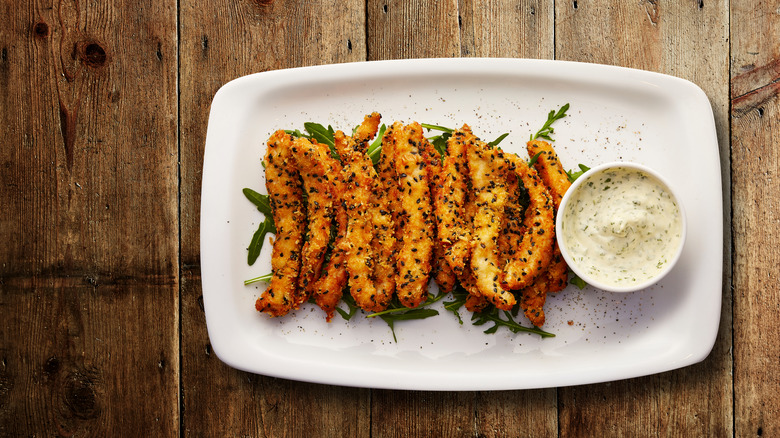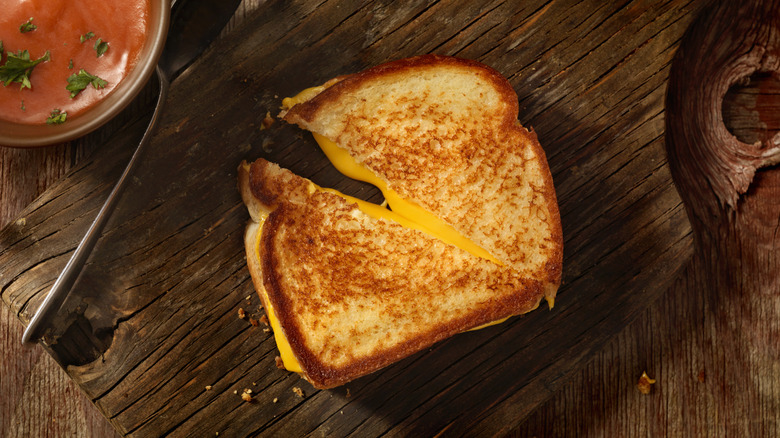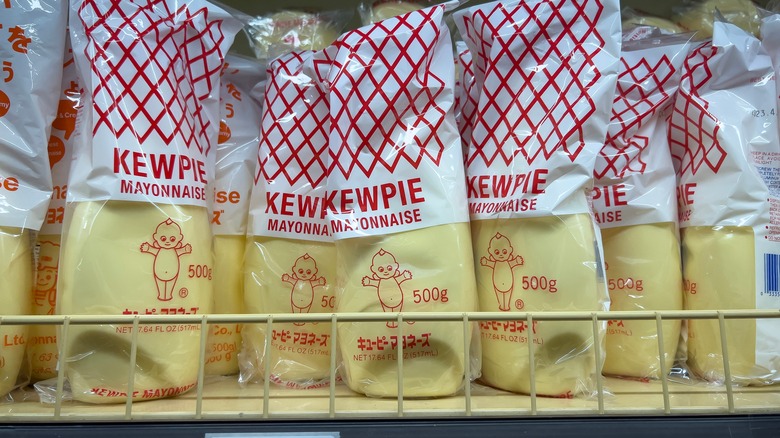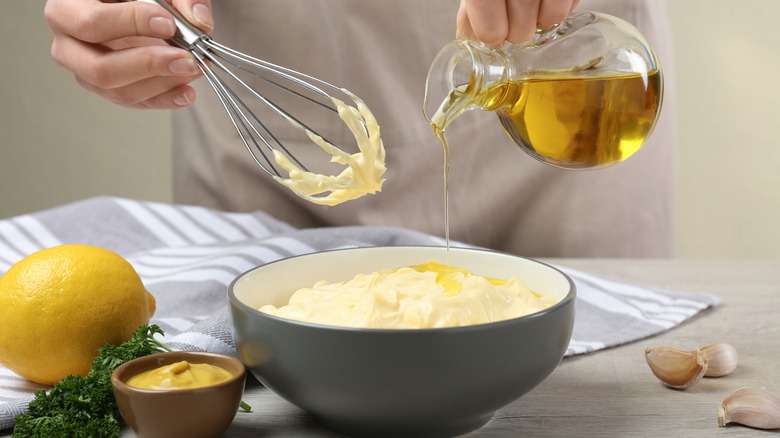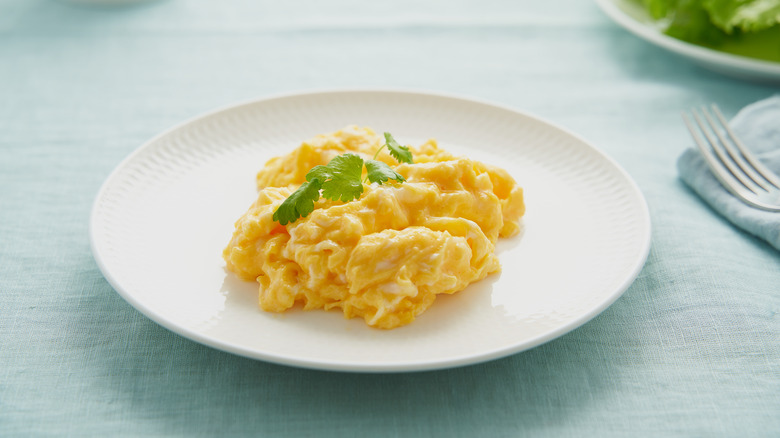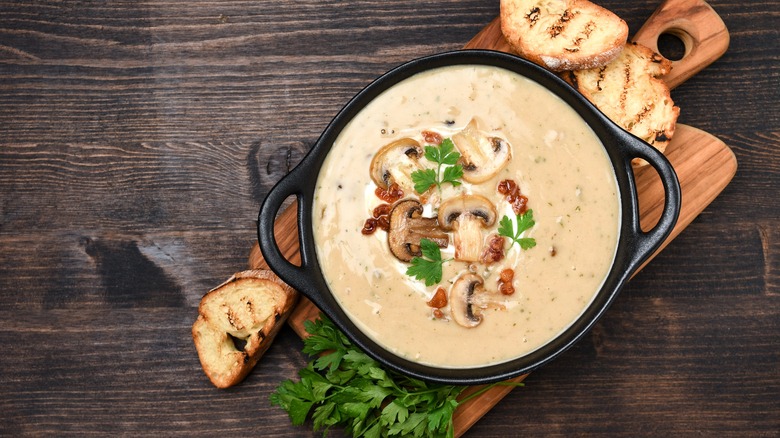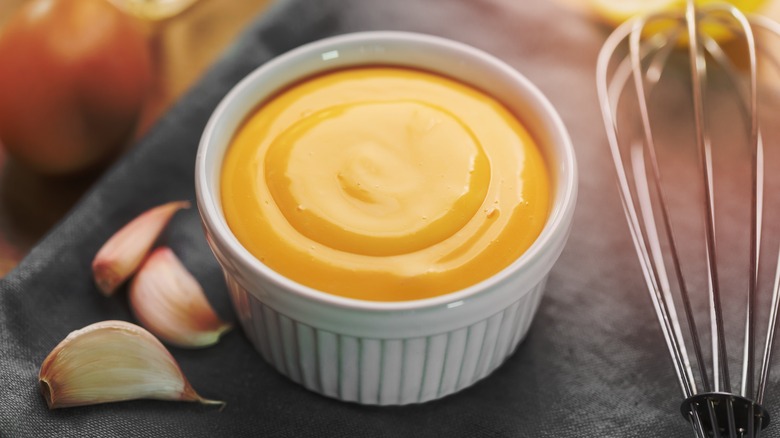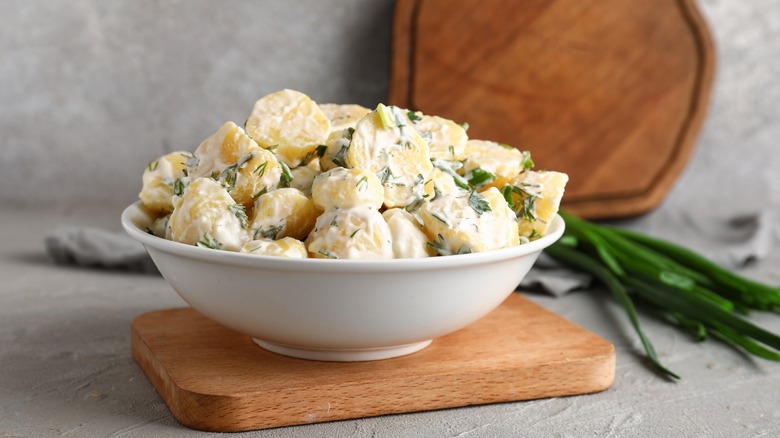14 Mayonnaise Blunders You Need To Avoid
In a world of a million different condiments, mayonnaise reigns supreme. The spread — which is made from oil, water, eggs, acid, and other ingredients — is almost absurdly popular. Mayonnaise finds its way into our meals on an almost daily basis. According to Statista, almost 277 million Americans used mayonnaise or mayonnaise-like products in 2020.
Part of the appeal of mayonnaise is the fact that it's not just for spreading on sandwiches. You can use mayonnaise in cake, sushi rolls, dips, home-baked rolls, or meat coatings.
As such a ubiquitous product, it's hard to mess up using mayonnaise — but it can be done. The condiment can be a minefield, with many people making it incorrectly, adding it to food at the wrong time, storing it the wrong way, or simply using the wrong amount in their dishes. Luckily, however, these things can be avoided by getting to know some classic mayonnaise blunders.
1. Always using store-bought mayo
Mayonnaise is available in virtually every grocery store in the country, and because it's so widely available, it can feel a little pointless to make it from scratch. If you haven't tried it, though, you're missing out. Homemade mayonnaise generally has a smoother, fresher taste than the store-bought kind. It also has a delightful aeration to it, which means that it's less dense. Because it's so simple to make and involves ingredients you usually have in your cupboards, making it can also be cheaper than buying a big jar, especially if you're only planning on using a small amount.
Homemade mayo also has the advantage of being free from the added preservatives that store-bought varieties can often have. These preservatives extend the shelf life of store-bought products. However, they can also alter taste. Bear in mind, though, that a lack of preservatives can produce certain problems with homemade mayonnaise, namely that it won't last as long as the store-bought kind. An added advantage of making mayo from scratch, however, is that homemade mayonnaise is way more customizable than store-bought, and you can imbue it with flavors that wouldn't have the same pop if you just stirred them into a jar.
2. Storing it incorrectly
Mayo is one of those products that we tend to pick a storage method for, and then stick to it for good. However, store-bought mayonnaise should actually be stored differently depending on whether it's open or not. When it's still sealed, there's no need to chill it. "While refrigerating unopened mayo can possibly extend its shelf-life and keep flavor intact, commercially produced mayo contains ingredients that prevent spoilage, unopened, at room temperature," registered dietitian nutritionist Ginger Hultin explains to Southern Living. These ingredients, which are usually a combo of acids and preservatives, stop bacteria from forming, and the limitation of air to the product prevents it further.
Once mayo's open, however, it's another story. Provided that you keep it consistently chilled, your product will likely last for a good few months in the fridge, but taking it out and allowing it to warm up may increase the likelihood of spoilage. It's best to pop your mayo at the back of your fridge, ideally on the bottom shelf, where it'll be less likely to fluctuate in temperature. If placed in the door, it will be more frequently exposed to warm air when you open your refrigerator, and this could cause it to go bad faster.
3. Assuming reduced fat mayo is healthier
Regular mayonnaise is made mostly from fat, due to the condiment being made primarily from egg yolks and oil. This has led to a host of food manufacturers offering "reduced fat" or "light" mayos, frequently marketed at folks who seek to live a healthier lifestyle. These mayonnaise products, however, may not be strictly healthier. In fact, they may be worse for some diets.
Reduced fat and light mayos are usually lower in fat and calories than standard mayonnaise, but the trade-off is that they may contain more carbohydrates. These carbs are often in the form of sugar or starch added to improve flavor or texture without the need for fats. The issue, however, is that these carbs can often go unnoticed, elevating your amount throughout the day. If you're following a low-carb diet, like the keto diet, they can make what's usually a keto-friendly food item an ingredient that could cause issues.
It's important to remember these mayonnaises can be a part of a balanced diet. As the fats in these types of mayo are predominantly unsaturated, they may not have as much impact as other saturated fat-heavy food products on the potential for conditions like heart disease (per the NHS).
4. Only using it in savory dishes
Mayonnaise is a staple in a load of savory meals, usually as a spread or the base of a dip. One key thing people forget about it, though, is that it's just as good when used in some sweet recipes. One of the best uses for mayonnaise is as a substitute for oil or butter in baking. Mayo's inherent creaminess makes it a pretty even swap for butter, and helps to provide the moisture that the fat would otherwise deliver.
The eggs in mayonnaise also have a binding and stabilizing effect when combined with flour and other dry ingredients. If you're worried about mayonnaise making your bakes taste strange, too, don't fret too much. Mayo's light tanginess and gentle saltiness both help to intensify the sweetness in cakes, especially those that are flavored with chocolate. But while mayonnaise is usable in many recipes, it may not suit everyone. You should avoid using it in bakes where butter or a certain type of oil is a key flavor. Nor should it be used if your butter has a textural function, like in puff pastry, where the evaporating moisture in the fat helps to create layers.
5. Putting too much of it in your meals
Turns out you can have too much of a good thing, folks. Mayonnaise is an excellent ingredient for adding much-needed moisture and creaminess to foods that would otherwise be pretty dry or claggy, like potatoes or bread. Using too much, though, can leave things a little sloppy. This is especially noticeable if you're using mayo to make a salad or side dish, like coleslaw or potato salad. If you put too much in, the textural components of your dish will be lost in a moist, dense mass of mayonnaise, and the whole thing will lose any layered flavor.
Luckily, there are a few easy fixes if you add too much mayo. For potato salad, it's best to try and balance it out by adding some more of the other ingredients. If you have yet to add any additional seasonings or flavor components to your dressing, you can also simply spoon or strain some of the mayonnaise out. If you've added too much mayo to a sandwich, it's usually best to scrape some of it away before you add your fillings or add more filling to counteract it. You can also try placing another slice of bread in the middle of your sandwich, to give it extra structural support that may be lost by an overabundance of spread.
6. Not pairing the condiment with your food's flavors
Sometimes, basic mayo just doesn't cut the mustard. Although unflavored mayonnaise can give food moisture and slight acidity, it can also sometimes work against other flavors, becoming a distraction from the central taste profile of your dish. Too many people forget that mayo can, and often should, be imbued with other complementary flavors that intensify the taste of your sandwich, wrap, or appetizer.
If you're serving a Japanese-inspired squid or shrimp tempura starter, for example, mixing wasabi and lime into mayonnaise, instead of serving them separately, can bolster the dish's flavors and contrast its crunch and fattiness. Steak sandwiches — which benefit from herbal counterpoints and frequently use mayo — can have the herbs mixed directly in. This will also stop them from falling out of your bread. If you're serving barbecue, using plain mayonnaise will neutralize the punch of your barbecue sauce or flavors — but mixing barbecue sauce with mayonnaise creates a mellow accompaniment that creates extra moisture.
Don't forget, too, that this rule also applies to any dressings you make with mayo. For example, if you're making a peppery coleslaw with radish and kohlrabi, avoid using regular mayonnaise and create one imbued with black pepper, lemon, and a touch of honey, to underline the vegetables' natural notes.
7. Forgetting to put it on the outside of your sandwich
Everyone knows that mayo shines best when it's slathered inside a sandwich. A big mistake people often make, though, is forgetting that it's as good on the outside as well. Importantly, this is only the case for sandwiches like grilled cheeses or paninis, which are fried, pressed, or air-fried before eating. Using mayonnaise in place of butter to cook these sandwiches provides the same crispiness and golden-brown tinge that the fat does, and does so in a form that's arguably way more easily spreadable.
Using mayonnaise in place of butter also gives your sandwich a slightly different flavor profile. Whereas butter provides top notes of creaminess and dairy, mayonnaise has a slightly sharper taste. This could be preferable as a counterpoint to certain flavors, for example, if you're making a grilled cheese with a particularly mild or subtle-tasting cheese, like mozzarella.
Crucially, using mayonnaise on the outside of a sandwich only works if it's full-fat. You need high levels of fat for it to be able to cook effectively and create a good browning. If you try using reduced fat or light mayo, it will make your bread too moist, and simply steam when it hits the heat.
8. Not thinking about the ingredients in your favorite brand
No two mayonnaise brands are made in the same way — but way too many people think that they are. This leads to confusion and disappointment when you sub out your favorite brand for an alternative, and end up with a different flavor. It should be remembered that different proportions of ingredients in mayonnaise recipes can make them more acidic, saltier, or fattier, and certain brands use different oils or egg combinations.
Kewpie mayo, for example, skips the whole eggs that mayo recipes often use, and instead just uses egg yolks. This gives it a creamier, more luxurious taste, and a slight yellow tinge. Other mayonnaise brands may also use certain seasonings in their recipes that give them extra depth, while certain types (like Kewpie) contain monosodium glutamate, imbuing it with a slightly savory taste. The American version of Kewpie is even made with yeast extract. Remember, too, that reduced-fat or light mayo brands may have more sugar in them than full-fat versions, and this will not only alter their nutrition but may make them taste sweeter.
9. Adding your oil too quickly
Rustling up some homemade mayo can be satisfying, but it's not as easy as it looks. One of the main issues that can occur when you're making it from scratch is splitting, which is when oil separates from the other ingredients. This usually occurs when you don't give the oil and the eggs enough time to emulsify with the acidic element of lemon juice or vinegar, which is what makes the eventual mixture so creamy.
The way of getting around this, though, is by exercising patience. When making homemade mayonnaise, you need to add the oil incredibly slowly, gently incorporating it with the eggs. It's easier to do this if you're whisking it by hand, as the slower process will prevent you from being tempted to dump it in all at once and allow you greater control. If your mayo does split, you can quickly rectify it by boiling a kettle and adding a tiny amount of boiling water to the mixture, whisking it in. This will help the ingredients re-incorporate and smooth things out. However, if boiling water doesn't do the trick, it's best to start over from scratch — so make sure you're buying enough ingredients to cover your bases, should something go wrong.
10. Forgetting to put the condiment in basic meals
Too often, we forget that mayo isn't just a spread or a condiment, but an ingredient in its own right — and one of the best ways to use it is to add it to simple, everyday meals, to add texture and taste. For example, using a spoonful of mayo is the secret to elevated scrambled eggs. This elite trick sees you whisking your mayonnaise straight into your egg mixture before you cook it all together in the pan.
While this sounds like it could be a disaster, it makes way more sense than you might think. Mayonnaise is primarily made from eggs and oil, and as such, its natural taste aligns seamlessly with the scramble mix and serves to make it more tender and rich. Using mayonnaise also provides added flavor elements that lift your eggs, thanks to its acidity and slight saltiness. You therefore end up with pleasingly tangy scrambled eggs that are fluffier and creamier than if you made them using milk. Mayo can also be used in any cream-based sauces you might be making, like Alfredo, where it helps to thicken the mixture and provide additional rich flavor.
11. Using another ingredient instead of mayo
If you're making a new dish and haven't read the recipe properly, you can be blindsided by an additional ingredient you didn't know you needed. Instead of running to the store, use mayo. Too many people forget that mayonnaise can capably take the place of numerous ingredients in recipes, especially cream and full-fat milk, without providing any significant alterations to its taste.
It's most useful in dishes where these ingredients are used as thickening agents, like soup. When you add a dollop of mayo to soup, the mayonnaise melts slightly and spreads through the liquid, providing bulk. It also helps to emulsify the other ingredients in your soup, bringing and binding them together to thicken the whole concoction.
Mayonnaise can also be used instead of butter, where the fat thickens sauces, such as in moules marinières. As mayonnaise is high in fat, it can replace the dairy fats in butter. The light tartness of mayo also underpins the brinier flavors in the dish and works well with the wine included in it. Remember, as well, that mayonnaise is also particularly good as a thickener for cold sauces, where you might normally use sour cream or créme fraiche.
12. Forgetting to spruce it up
One of our favorite things about mayo is how workable it is, with innumerable dishes made better by a quick dollop. However, it's also easy to forget that mayonnaise is, in itself, a pliable ingredient. Using just a whisk and a few extra ingredients, you can make your condiment into something special — and you'll likely have the additions you need in your cupboard already.
For a quick spicy accompaniment to your fries or chicken wings, make a sriracha mayonnaise. All it takes is equal parts mayo and sriracha, with a spritz of lemon juice to finish things off. We prefer to use a richer mayonnaise here, like Kewpie, as it's more equipped to temper the spiciness of the sriracha sauce. Otherwise, the heat can end up becoming slightly overpowering.
To take a more European route, a classic garlic aioli can be made by cutting out the laborious mixing process, and simply stirring minced garlic into some store-bought mayonnaise. Again, a squeeze of lemon juice is handy here, as it helps to cut through the rawness of the garlic. If you want to amp up the lemony notes, try grating in a little of its zest.
13. Adding it to food too quickly
Mayonnaise is a central component in many meals and is perhaps most commonly used outside of a sandwich spread as a base for coleslaw and potato salad dressing. However, things can go awry if you add it to these dishes too quickly. With potato salad, in particular, you need the mayo to hold the ingredients together and serve as a thick, creamy base. Unfortunately, though, if you add it to the potatoes while they're still hot, the mayo will thin and melt, leaving you with a watery, oily disaster.
Adding mayonnaise to coleslaw too quickly can also have downsides, especially if you've already seasoned it. Once you add your salty mayo to the cabbage, it starts to draw the water from the vegetable, resulting in a dressing that's way too watery. It's therefore best to wait until just before you're about to serve the coleslaw to add your mayo-based dressing.
On the other hand, there are certain instances where your food should be warm when adding mayonnaise or a mayo dressing. When making pasta salad, adding it to warm pasta allows the mayo to be absorbed somewhat by the noodles, which makes each bite way more flavorful and tender. It's best not to do this when the pasta is piping hot, though, as it may make the dressing too thin.
14. Freezing your mayo
What do you do if you've bought, or made, way too much mayonnaise? Freezing it can seem like a sensible storage option, to ensure that it stays fresh for the months ahead. Unlike many foods, though, mayo is unsuitable for freezing, and both the raw product and any foods that feature it significantly should be left away from your deep freeze.
While mayonnaise technically can be frozen, it starts to break down in the freezer pretty quickly, due to the emulsification separating. When you then defrost it, it splits and becomes difficult to reincorporate. Although you might be able to re-emulsify the mixture, it will lose its thickness and bulk, and end up overly watery.
Instead of facing this, it's better to avoid placing mayo-based food items in the freezer entirely. Remember that most store-bought mayos will last for a good amount of time in the fridge, and will be shelf-stable if unopened, so you don't have to waste valuable freezer space on them. For foods that contain mayo, like coleslaw, you might prefer to freeze the vegetables separately and make the dressing just before serving it.
